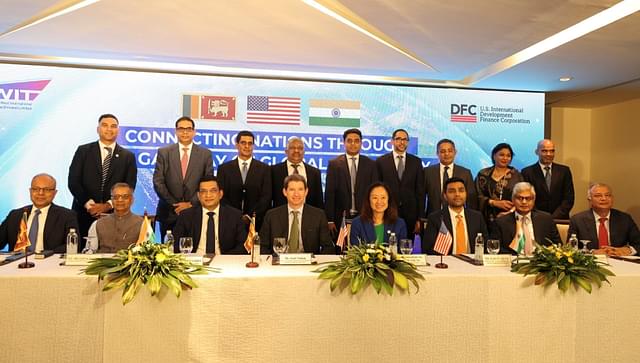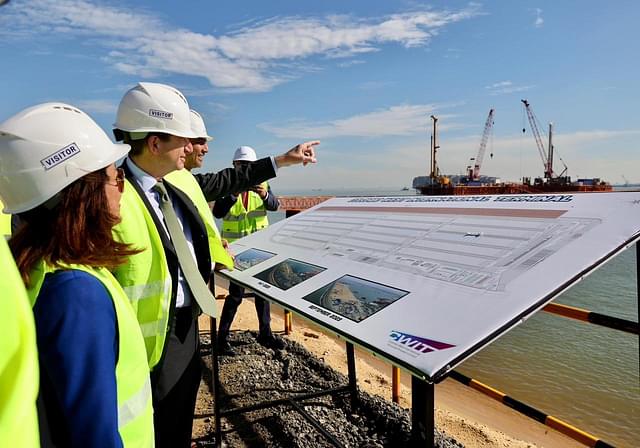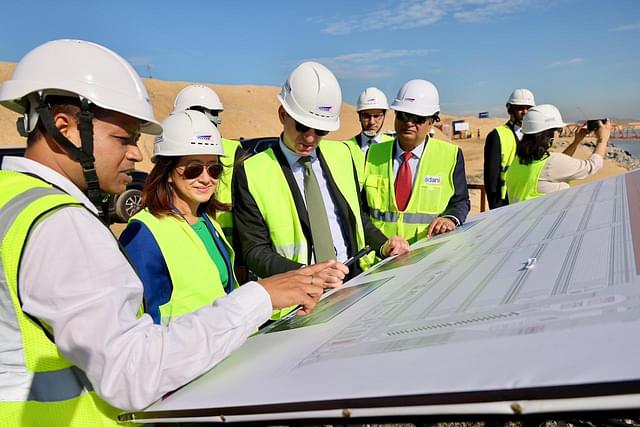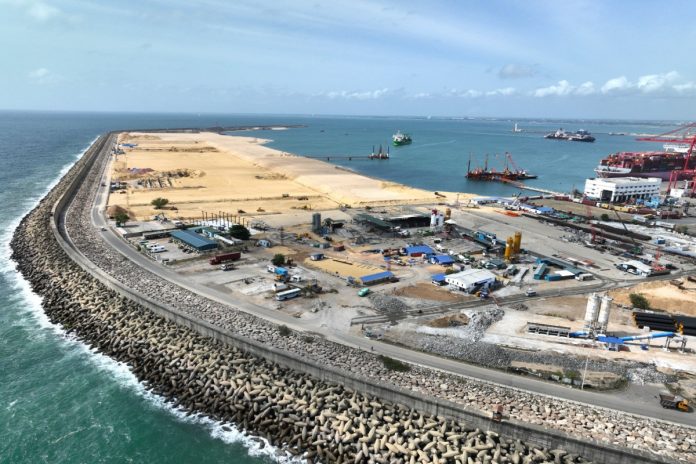In a development that underscores a silent change taking place in Asia, the U.S. International Development Finance Corporation (DFC) on Wednesday (8 November) announced a $553 million (Rs 4,118.89 crore) loan to Colombo West International Terminal Private Limited (CWIT), that is partly owned by the Adani Group.
This funding will support the development, construction, and operation of the West Container Terminal, a deep-water container facility at the Port of Colombo that will strengthen Sri Lanka’s position as a global logistics hub and boost their export capabilities in the Indo-Pacific.
DFC Chief Executive Officer (CEO) Scott Nathan traveled to Sri Lanka to publicise the commitment and was joined by US Ambassador to Sri Lanka Julie Chung and Lankan Foreign Minister Ali Sabry for the ceremonial launch of the new terminal.

The high-quality infrastructure project loan is the first time that the US government, through one of its agencies, is funding an Adani project.
Colombo Port Expansion Project
The Port of Colombo is the largest and busiest trans-shipment port in the Indian Ocean. It has been operating at more than 90 per cent utilisation since 2021, signalling its need for additional capacity.
To expand shipping capacity, the Sri Lanka Port Authority (SLPA) in April 2008 started the Colombo Port Expansion Project (CPEP) with the assistance of the Asian Development Bank (ADB).
The Port Expansion Project involved the development of three new terminals, each of which would provide an additional capacity of 2.4 million Twenty-Foot Equivalent Units (TEU), thereby increasing the overall container-handling capacity by 7.2 million TEU.
The first of these, the South Container Terminal (SCT) was operationalised in April 2014 and is operated by Colombo International Container Terminals Limited (CICT), a joint venture company between China Merchants Port Holdings Company Limited (CMPH) and SLPA.
CMPH holds 85 per cent of the partnership whilst the balance 15 per cent is being held by SLPA.
Whereas the East Container Terminal (ECT), which will be constructed in three phases, is scheduled to be completed in 2024.
The construction of the East Container Terminal at the Port of Colombo is being undertaken by a joint venture led by Access Engineering PLC, a Sri Lankan company, and includes China Harbour Engineering Company (CHEC).
The ECT development project had become a controversial political issue in Lanka with President Gotabaya Rajapaksa’s administration reneging a previously entered trilateral agreement with India and Japan to develop the ECT.
India, Sri Lanka, and Japan signed a trilateral Memorandum of Cooperation (MoC) in May 2019 to develop and operate the ECT. As per the agreement signed by the former Maithripala Sirisena-Ranil Wickremesinghe administration, India and Japan together were to hold 49 per cent stake in ECT.
President Rajapaksa had declared that he wanted the India-Japan deal on the ECT to go ahead. However, after weeks-long protests by trade unions who wanted the terminal to remain 100 per cent owned by the SLPA as opposed to the 51 per cent, the government cancelled the India-Japan ECT deal.
West Container Terminal Project
The $700 million West Container Terminal (WCT) project was offered as a “compromise” to India after Colombo “unilaterally” cancelled the 2019 ECT agreement and is said to be the largest foreign investment in the island nation’s ports sector.
It is being developed by Colombo West International Terminal Private Limited — a consortium of three parties led by Adani Ports — on a Build, Operate and Transfer (BOT) basis for 35 years.

As the first-ever Indian port operator in Sri Lanka, Adani Group has a majority stake of 51 per cent in the project; John Keells Holding (JKH), the largest public listed conglomerate in Sri Lanka has a 34 per cent stake and the Sri Lanka Ports Authority holds the remaining 15 per cent.
Dredging for the terminal commenced in November 2022 and the entire project is slated to be ready by the end of 2025.
When commissioned, CWIT will be the largest and deepest container terminal in Sri Lanka and will be able to handle Ultra Large Container Vessels with capacities of 24,000 TEUs. The new terminal’s annual cargo handling capacity is likely to exceed 3.2 Million TEUs.

The new terminal will cater to growing economies in the Bay of Bengal, taking advantage of Sri Lanka’s prime position on major shipping routes and its proximity to these expanding markets.
China’s Presence ?
The DFC funding is an example of how countries such as the US and India want to counter China’s influence in the island nation of 22 million, one of the world’s key transit hubs, with half of all container ships transiting through its waters and currently amid a financial crisis.
Cash-rich China has invested millions of dollars in Sri Lanka’s infrastructure since the end of a brutal civil war in 2009. It has financed nearly 300 projects on the island since 2000, according to the AidData lab at William & Mary College, providing aid and credit totalling more than $20 billion, with Colombo being a major participant in Beijing’s Belt and Road Initiative (BRI).
In 2017, Colombo signed a $1.1 billion deal to sell a 70 per cent stake of the strategic Hambantota port to China. Under the 99-year lease agreement, China’s state-run conglomerate China Merchant Port Holdings (CMPort) will invest up to $1.1 billion in the port and marine-related activities.
Additionally, China Harbour Engineering is involved in strategic infrastructure projects, including the $1-billion Colombo Port City Project coming up near Galle and a four-lane elevated highway connecting Colombo’s suburbs.
However, the situation changed last year, when Sri Lanka became the first Asia-Pacific country in more than two decades to default on its foreign debts. Excessive borrowing from China which exacerbated Sri Lanka’s crisis, has created an opening for other major players to forge closer economic ties with Lanka and taper down the dragon’s influence.
To put this in perspective, DFC’s private sector-driven investments in Sri Lanka of close to $1 billion have positioned the country as DFC’s second-largest market in the entire Indo-Pacific region, thereby, acting as a counterweight to China’s growing aggressiveness over the years.
DFC’s commitment of $553 million in private-sector loans for the West Container Terminal “will expand its shipping capacity, creating greater prosperity for Sri Lanka – without adding to sovereign debt – while at the same time strengthening the position of our allies across the region”, said Nathan.
For Sri Lanka, the investment reflects the robust economic recovery the small nation has made in the aftermath of the debt crisis and is expected to boost its economic growth and enhance the regional shipping capacity.
“I am confident that Sri Lanka will continue to attract key investments such as this in the coming months and years, and that we will be a preferred destination in the region for investors,” said Ali Sabry.
Promise For Adani
The investment by the United States is being touted as an endorsement of the Adani Group which has been scrambling to undo the damage from a scathing report by Hindenburg Research on 24 January this year.
US-based short seller Hindenburg Research in its report accused the ports-to-power group of “brazen accounting fraud” and share-price manipulation, which triggered a stock rout and wiped about 20 per cent off the Adani empire’s market value.
Since then, the group has been trying to make a comeback and the US’s financial backing could not have come at a better time. In a statement, Adani Ports described the loan as “a ringing endorsement of the Adani Group, and its ability to create a world-class container facility in Colombo Port”.
“We welcome the association of the DFC in funding the Adani project and we see this as a reaffirmation by the international community of our vision, our capabilities and our governance,” said Karan Adani, CEO of Adani Ports.
The silent change unfolding in Asian waters is being seen as an answer to China’s increasing aggression, and the world will undoubtedly closely monitor the dragon’s reaction.


